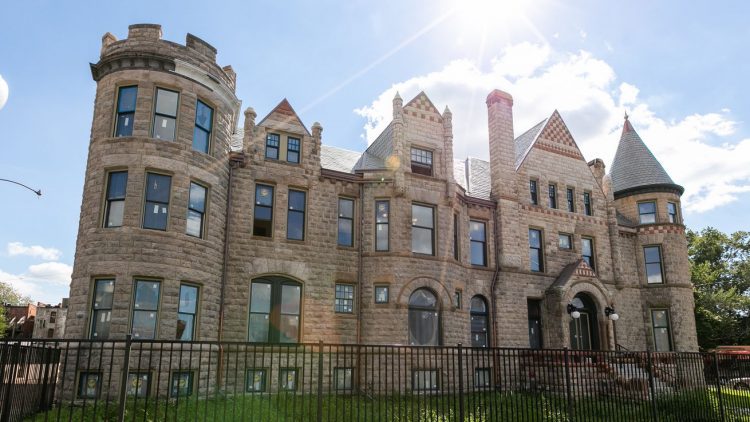

The James Scott Mansion | Photo by Michelle & Chris Gerard
Once doomed, these incredible pieces of Detroit architecture have been saved
Many pieces of historic architecture in Detroit, like the Hudson’s Department Store or Lafayette Building, have been demolished and lost to time. And there’s others, like the Lee Plaza or Eddystone Hotel, which are in rough shape and have difficult paths to redevelopment.
But in recent years, dozens of important buildings have been bought and redeveloped. For some, this outcome seemed unlikely. Check out this Curbed Detroit map from 2014 about buildings that need to be saved and notice how many have in just five years time.
Today, we’re highlighting six in various stages of readiness. Hopefully, we’ll have many more in the future.
Metropolitan Building
/cdn.vox-cdn.com/uploads/chorus_asset/file/13112319/metrowindows.jpg)
Courtesy of the Roxbury Group
Destined for demo in 2013, the 14-story Metropolitan Building opened as the Element Hotel earlier this year. Led by the Roxbury Group and the Means Group, the Metropolitan is a 110-room extended-stay hotel with an incredible rooftop bar, The Monarch Club.
During the 40 years it was vacant, scrappers had taken most parts of value and the city had even erected nets to catch debris from its collapsing facade. To get a sense of how much work was required to bring the building back to life, check out these incredible before and after photos.
Wurlitzer Building
/cdn.vox-cdn.com/uploads/chorus_asset/file/8729409/Wurlitzer_129.jpg)
Photo by Michelle & Chris Gerard
Much like the Metropolitan, the Wurlitzer had parts falling from its facade and looked like it was doomed as well. That is, until Ash NYC bought the narrow 1926 building and redid it into the chic Siren Hotel, which opened in March 2018. No need for the infamous sign from its coffee shop neighbors anymore, offering free coffee to anyone who bought the Wurlitzer.
James Scott Mansion
/cdn.vox-cdn.com/uploads/chorus_asset/file/13167749/RestoredBuildings_108.jpg)
Photo by Michelle & Chris Gerard
For decades, the James Scott Mansion, which dates back to the 1890s, had been a partial shell of a house (exterior pics from 2014 can be seen here).
Joel Landy bought the property in 2002, but had trouble getting funding for the rehab. Signs of life crept back in and renovations started on the property in 2016. The building, with its 26 residential units and commercial tenant, officially opened in February this year.
Forest Arms Apartments
/cdn.vox-cdn.com/uploads/chorus_asset/file/13167753/RestoredBuildings_109.jpg)
Photo by Michelle & Chris Gerard
This Midtown apartment building was nearly destroyed by a massive fire in 2008. Developer Scott Lowell took on the project after the owners thought they might tear it down. Most of the fire damage was on the top floors, but some water and smoke damage made its way through the rest. Still, it had details worth saving.
Work intensified over the years, and was completed in 2016. All could have been lost in this impressive building, but now it houses 70 apartment units.
Park Avenue Building
/cdn.vox-cdn.com/uploads/chorus_asset/file/13167761/RestoredBuildings_100.jpg)
Photo by Michelle & Chris Gerard
Last year, the Park Avenue Building at Grand Circus Park was falling apart. Literally. This building had also faced demo in recent years, like its neighbor the Hotel Charlevoix (now a parking lot). The longtime owner of both buildings, Ralph Sachs, died in 2017 and the Park Avenue is now under new ownership. It was recently profiled in the Detroit News as the last “dangerous” building in downtown Detroit.
It’s new owner Rino Soave is planning to renovate the building into 78 apartments at a cost of $22 million. Though work hasn’t started, Crain’s Detroit Business reported that construction should start soon and will take around two years.
Michigan Central Station
/cdn.vox-cdn.com/uploads/chorus_asset/file/9664025/2I1A4052.jpg)
Photo by Michelle & Chris Gerard
The most surprising rescue project of all.
A year and a half ago, it was hard to imagine the old train station being put to good use again. It had been owned by the Moroun family for decades, just sitting there, looming as the symbol of Detroit’s decay.
Rumors started last year of the Ford Motor Company buying the station, which almost seemed too good to be true. All was confirmed in June 2018, with a big celebration and plans to bring thousands of mobility-focused employees into Corktown, with the train station as its centerpiece.
So far, Ford has winterized and secured Michigan Central Station, which included installing a temporary roof and cleaning the building of debris. Full redevelopment will take a few years—and a lot of money and tax incentives—but Michigan Central Station will be open again.

Register using email address or your Facebook profile or Google account